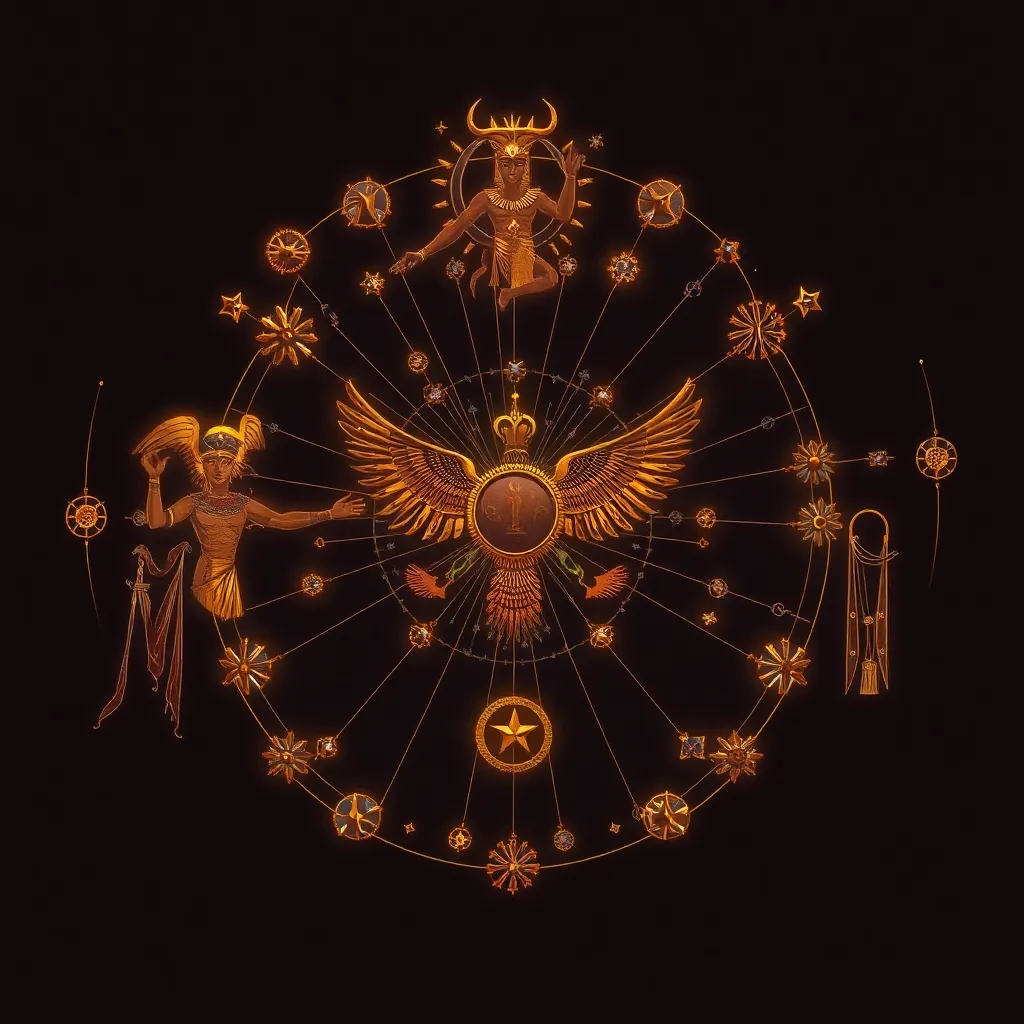The Interconnectedness of Gods: A Web of Egyptian Cosmology
I. Introduction to Egyptian Cosmology
Egyptian cosmology is a foundational aspect of ancient Egyptian culture, framing their understanding of the universe and the divine. This complex system of beliefs encompasses myths, gods, and the nature of existence itself. The significance of cosmology in ancient Egypt lies in its ability to explain the origins of the world, the role of deities, and the connection between humanity and the divine.
The pantheon of Egyptian gods is vast and varied, featuring major deities such as Ra, Osiris, and Isis, each serving specific roles that contribute to the maintenance of order and balance in the universe. Exploring the interconnectedness of these deities reveals the intricate relationships and dynamics that shaped ancient Egyptian spirituality.
II. The Creation Myth: Atum and the Emergence of the Gods
Central to Egyptian cosmology is the Heliopolitan creation myth, which describes how the universe came into being. According to this myth, Atum, the first god, emerged from the primordial chaos of Nun. Atum is depicted as the creator of himself, representing the concept of self-creation and the beginning of life.
From Atum, the divine offspring known as the “Ennead” emerged, consisting of nine gods: Atum, Shu, Tefnut, Geb, Nut, Osiris, Isis, Seth, and Nephthys. This Ennead illustrates the interconnectedness of the gods, as each deity plays a crucial role in the cosmic order and the unfolding of creation.
III. The Duality of Order and Chaos: Ma’at and Isfet
In Egyptian thought, the concepts of Ma’at (order) and Isfet (chaos) are fundamental. Ma’at represents truth, justice, and cosmic order, whereas Isfet embodies chaos, disorder, and injustice. The gods are tasked with maintaining the balance between these two forces, with many deities personifying aspects of both.
The interactions between gods representing Ma’at and Isfet highlight the importance of balance in the universe. For instance, the conflicts between Osiris and Seth demonstrate the ongoing struggle between order and chaos, illustrating how the gods’ relationships are integral to maintaining harmony in the cosmos.
IV. The Interrelation of Major Deities
The relationships among key deities such as Osiris, Isis, Horus, and Seth are central to understanding Egyptian cosmology. These gods are interconnected through a web of family ties, rivalries, and alliances that shape the narrative of creation and the afterlife.
- Osiris: God of the afterlife, representing resurrection and eternal life.
- Isis: Goddess of magic and motherhood, known for her devotion to Osiris and her role in resurrecting him.
- Horus: The son of Osiris and Isis, often depicted as a falcon, symbolizing kingship and protection.
- Seth: The god of chaos and storms, often in conflict with Horus, representing the struggle for the throne.
The symbolism of these relationships extends to the broader culture of ancient Egypt, where the struggle between Osiris and Seth represents the eternal battle between order and chaos, life and death, and the cyclical nature of existence.
V. The Role of Lesser Deities and Spirits
While the major deities play prominent roles in Egyptian mythology, a vast array of lesser gods and spirits also contribute to the cosmological framework. These lesser deities often serve specific functions related to daily life, nature, and the afterlife.
- Heka: The god of magic, essential for rituals and protection.
- Bes: A household god known for protecting mothers and children.
- Khnum: The god of the Nile, associated with fertility and creation.
The interconnected roles of these lesser deities with major gods emphasize the complexity of the divine hierarchy and its influence on various aspects of life, including agriculture, health, and protection in the afterlife.
VI. The Influence of Geography on Divine Interconnectedness
The geography of ancient Egypt, particularly the Nile River and the surrounding landscapes, greatly influenced the relationships among the gods. The Nile was not only a life-giving force but also a symbol of divine intervention and protection.
Different regions of Egypt had varying worship practices and local deities, leading to a rich tapestry of beliefs and rituals. Temples and sacred spaces served as focal points for worship, fostering connections between the divine and the earthly realm.
For instance, the worship of Sobek, the crocodile god, was more pronounced in the regions surrounding the Nile, highlighting the geographical influence on divine relationships and worship.
VII. The Evolution of Egyptian Cosmology Over Time
Egyptian cosmology did not remain static; it evolved over millennia, influenced by historical events, foreign cultures, and political changes. The pantheon of gods saw shifts, with some deities rising to prominence while others faded into obscurity.
The introduction of foreign religions, such as Christianity and later Islam, altered the landscape of Egyptian beliefs. Additionally, the consolidation of power by various dynasties often led to the elevation of specific deities, impacting worship practices and the overall cosmological narrative.
VIII. Conclusion: The Legacy of Egyptian Cosmology
The interconnectedness of the gods within Egyptian cosmology reveals a complex and dynamic understanding of the universe. These divine relationships shaped not only the spiritual beliefs of ancient Egyptians but also their cultural practices and societal structures.
The legacy of Egyptian cosmology continues to influence modern spirituality and mythology. By understanding these connections, we gain insights into the ancient worldview and the significance of balance, harmony, and the interplay between order and chaos in our own lives.
In a contemporary context, the study of Egyptian cosmology encourages a deeper appreciation for the rich tapestry of human belief systems and the universal quest for meaning and understanding of our place in the cosmos.




